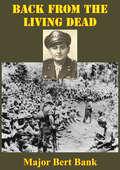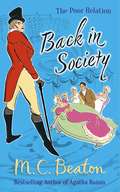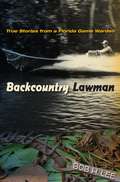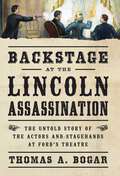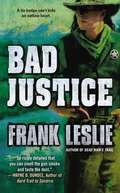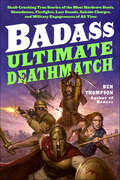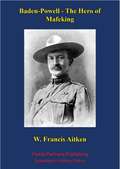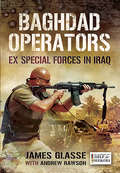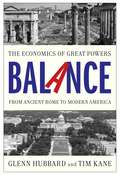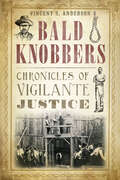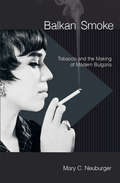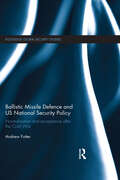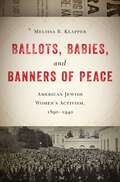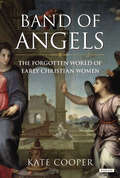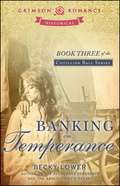- Table View
- List View
Bach: Music in the Castle of Heaven
by John Eliot GardinerJohann Sebastian Bach is one of the most unfathomable composers in the history of music. How can such sublime work have been produced by a man who (when we can discern his personality at all) seems so ordinary, so opaque--and occasionally so intemperate? John Eliot Gardiner grew up passing one of the only two authentic portraits of Bach every morning and evening on the stairs of his parents' house, where it hung for safety during World War II. He has been studying and performing Bach ever since, and is now regarded as one of the composer's greatest living interpreters. The fruits of this lifetime's immersion are distilled in this remarkable book, grounded in the most recent Bach scholarship but moving far beyond it, and explaining in wonderful detail the ideas on which Bach drew, how he worked, how his music is constructed, how it achieves its effects--and what it can tell us about Bach the man. Gardiner's background as a historian has encouraged him to search for ways in which scholarship and performance can cooperate and fruitfully coalesce. This has entailed piecing together the few biographical shards, scrutinizing the music, and watching for those instances when Bach's personality seems to penetrate the fabric of his notation. Gardiner's aim is "to give the reader a sense of inhabiting the same experiences and sensations that Bach might have had in the act of music-making. This, I try to show, can help us arrive at a more human likeness discernible in the closely related processes of composing and performing his music." It is very rare that such an accomplished performer of music should also be a considerable writer and thinker about it. John Eliot Gardiner takes us as deeply into Bach's works and mind as perhaps words can. The result is a unique book about one of the greatest of all creative artists.
Back From The Living Dead: An Original Story Describing The Infamous March Of Death; 33 Months In A Japanese Prison And Liberation By The Rangers
by Major Bert BankThe world famous story of Major Bertram Bert Bank who survived 33 months of prison, torture and starvation at the hands of the Japanese in the Philippines during the Second World War."He left us to go into service in 1941 and he was called up from inactive status on his reserve commission."From the time he left us until he came back this year, Bert went through a lot that many other men did not survive. He was taken prisoner of the Japs on Bataan, survived the Bataan March of Death and 33 months internment in a Jap prison camp. Now he's a patient at Valley Forge General Hospital where Army doctors are attempting to restore his sight to normal. The long, gruelling months on a meager diet took its toll."But Bert doesn't complain. "There are a lot of other fellows less fortunate than I," he will tell you."Many friends have asked him to tell of his experiences. During the course of bond tours and other public appearances in the Army's behalf, Bert has recounted these experiences. And so he thought he would write them down for these friends. That's the reason for this booklet."The story of his capture and internment are here in Bert's own words. He is the man identified as the Captain Bert of Alabama in the late Lieutenant Colonel Edward Dyess' story "The March of Death." Bert was scheduled to make a break from the Jap prison camp with Colonel Dyess but was sick at the time and could not make it."So this is the story of Major Bert Bank, a native Tuscaloosan and graduate of the University of Alabama. He's one of the men who came back from the "living dead.""
Back in Society (The Poor Relation #6)
by M.C. BeatonThe Poor Relation hotel is the toast of London and its owners are preparing to sell up and retire - but one last romantic adventure awaits them!Driven into hiding at the hotel by a tyrannous father and a rich but wizened suitor, Lady Jane Fremney attempts to end her life. The poor relations save the young lady and determine to improve her lot in life by bringing her out for the Season.All the young bucks call on Jane, among them the handsome but racy Comte de Mornay, an exile from Napoleon's France who has broken many a heart and so far eluded matrimony. Jane is quite adamant he is unsuitable for her - but when his life is threatened by an assassin's pistol, it is up to her to help him escape from danger... and into l'amour!
Back to Back (Books That Changed the World)
by Julia Franck&“[A] novel of fractured childhood in East Germany . . . a powerful elegy&” from the author of the international bestseller, The Blindness of the Heart (Booklist, starred review). Echoing themes of Julia Franck&’s German Book Prize–winning novel, The Blindness of the Heart, Back to Back begins in 1954 and centers around a single family living in Berlin in the socialist East. A cruel and unaffectionate mother, Käthe, is a sculptor of Jewish heritage, devoted entirely to becoming a success in the socialist state. Thomas and Ella&’s father emigrated to West Germany after World War II, and they deeply long to see him again. But Käthe&’s hard-nosed brutality—a reflection of the materialistic, unsentimental state in which she lives—means Thomas and Ella are unable to live the lives they want to. As the siblings grow up, &“the enchanted bubble of childhood fades, replaced by a sense of pitiless confinement—an ideological claustrophobia made concrete as the wall is constructed around them, touching off the book&’s devastating climax&” (Vogue). &“Like an expert geologist, Franck is digging deep into her family&’s extraordinary history creating things of great beauty from its dark recesses. Diamond-hard and full of glittering prose, Back to Back is a powerful and moving book. I suspect there are more gems to come.&” —Daily Telegraph &“Intoxicating . . . a curious fusion of stark realism tempered with quirkily stylistic flights of fancy: the trademark of one of Germany&’s finest contemporary novelists.&” —Literary Review &“Mournful and intense . . . captures a slice of life during a particularly harsh and brutal time and place, through the lens of a quickly disintegrating childhood innocence.&” —Bust Magazine
Backcountry Lawman: True Stories from a Florida Game Warden (Florida History and Culture)
by Bob H. LeeWith thirty years of backcountry patrol experience in Florida, Bob Lee has lived through incidents of legend, including one of the biggest environmental busts in Florida history. His fascinating memoir reveals the danger and the humor in the unsung exploits of game wardens.
Backstage at the Lincoln Assassination: The Untold Story of the Actors and Stagehands at Ford's Theatre
by Thomas A. BogarApril 14, 1865. A famous actor pulls a trigger in the presidential balcony, leaps to the stage and escapes, as the president lies fatally wounded. In the panic that follows, forty-six terrified people scatter in and around Ford's Theater as soldiers take up stations by the doors and the audience surges into the streets chanting, "Burn the place down!"This is the untold story of Lincoln's assassination: the forty-six stage hands, actors, and theater workers on hand for the bewildering events in the theater that night, and what each of them witnessed in the chaos-streaked hours before John Wilkes Booth was discovered to be the culprit. In Backstage at the Lincoln Assassination, historian Thomas A. Bogar delves into previously unpublished sources to tell the story of Lincoln's assassination from behind the curtain, and the tale is shocking. Police rounded up and arrested dozens of innocent people, wasting time that allowed the real culprit to get further away. Some closely connected to John Wilkes Booth were not even questioned, while innocent witnesses were relentlessly pursued. Booth was more connected with the production than you might have known--learn how he knew each member of the cast and crew, which was a hotbed of secessionist resentment. Backstage at the Lincoln Assassination also tells the story of what happened to each of these witnesses to history, after the investigation was over--how each one lived their lives after seeing one of America's greatest presidents shot dead without warning.Backstage at the Lincoln Assassination is an exquisitely detailed look at this famous event from an entirely new angle. It is must reading for anyone fascinated with the saga of Lincoln's life and the Civil War era.
Bad Books: Rétif de la Bretonne, Sexuality, and Pornography
by Amy S. WyngaardBad Books reconstructs how the eighteenth-century French author Nicolas-Edme Rétif de la Bretonne and his writings were at the forefront of the development of modern conceptions of sexuality and pornography. Although certain details are well known (for example, that Rétif’s 1769 treatise on prostitution, Le Pornographe, is the work from which the term pornography is derived, or that he was an avid foot and shoe fetishist), much of this story has been obscured and even forgotten: how the author actively worked to define the category of obscenity and the modern pornographic genre; how he coined the psycho-sexual term “fetish” and played a central role in the formation of theories of sexual fetishism in the late nineteenth and early twentieth centuries. Thus this book is also about literary history and how it is written: it explores how Rétif, perceived as a bad author in both senses of the term, and his contributions were glossed over or condemned, such that the originality of his texts has still not been fully established. Published by University of Delaware Press. Distributed worldwide by Rutgers University Press.
Bad Justice
by Frank LeslieSCARS RUN DEEP Colter Farrow's branded face is a constant reminder of why he's been on the run for so long. But his plan to return home and confront his past backfires when he's framed for the murders of two men. Men who turn out to be U. S. Deputy Marshals. Resigned to living on the lam, Colter heads to Utah Territory, where a desperate town marshal offers him a job as--of all things--a lawman. What better way for a man to hide from the law than to become part of it? Regardless of which side of the law he stands on, Colter makes enemies quickly. But Colter doesn't plan on letting them stay above ground for long. ... .
Bad Santas
by Paul HawkinsA gleefully dark and well-researched exploration of the history and customs of European Yuletide folklore. How did St Nicholas save children from cannibalism? Who were the Yule Lads and why would they steal your sausages? Why was the Alpine Father Christmas accompanied by a demonic figure called the Krampus who bundled children into sacks and dragged them off to Hell? And why do Spanish nativity scenes often feature a defecating peasant? Over the course of the 20th Century, a universal image developed around the world of Santa Claus as a kindly Christmas visitor but, prior to that, each country, town and community would have Christmas visitors of their own - sometimes human, sometimes animal, sometimes something else entirely - with their own curious set of mythology and customs. The Finns were visited by a pagan goat named Joulupukki that was said to eat anyone who misbehaved. In Iceland, it was said that any child who did not receive an item of new clothing for Christmas would be caught and consumed by the monstrous Christmas Cat! Bad Santas celebrates some of the most imaginative, terrifying and outright curious Christmas figures from across Europe - looking closely at its legacy of disquieting fairy stories. With beautiful black and white line drawings in each chapter, this unusual, entertaining and gleefully dark exploration of seasonal folklore will make an ideal Christmas gift and the perfect book for reading around the fireside.
Badass: Ultimate Deathmatch (Badass Series)
by Ben ThompsonFrom the Ben Thompson, author of Badass: The Birth of a Legend, comes a collection of history’s most awe-inspiring duels and showdowns, brutal crusades and epic brawls, and profiles of the fascinating people who fought in them.From Caliphs to Green Berets, some of civilization’s toughest warriors are profiled in Badass: Ultimate Deathmatch, including Cyrus the Great, St. Moses the Black, and The Rani of Jhansi, as well as in-depth analyses of how they battled their way to victory.Featuring original artworks by top graphic artists and comic book illustrators, and Ben Thompson’s signature wry, side-splitting commentary, Badass: Ultimate Deathmatch is the history of badasses, the only way it should be written: covered in blood!
Baden-Powell - The Hero of Mafeking
by W. Francis AitkenBaron Baden-Powell is nowadays remembered best for his work as the founder of the Scouting Movement which has gone on to become a world-wide success; however his initial reputation rested on his military career centred on the Boer War. Colonel Baden-Powell, as he then was, commanded at Mafeking and was charged with its defence no matter the odds. At his command he had few resources, even fewer men and slim prospects of holding out against overwhelming odds. What this book tells, with great gusto, is the miracle that Baden-Powell contrived to bring about by successfully defending Mafeking for seven months. His tactics were often unconventional but very effective in keeping up both the spirits of the townspeople and the Boers at bay. He set an example of sang-froid that was instrumental in ensuring the troops under his command did not give in to the fears of the odds facing them. The following anecdote is characteristic of him:"Soon after the redoubtable Cronje [The Boer General] took command of the Boer forces, he forwarded a demand for surrender, to avoid further bloodshed, to which the reply [Baden-Powell's] was, "When will the bloodshed begin?""Highly recommended.Author -- W. Francis AitkenText taken, whole and complete, from the edition published in 1900, London, by S W Partridge & Co.Original Page Count - 175 pages.Illustrations -- 1 Portrait.
Badlands Bride
by Adrianne WoodA fiery desert flower and an irresistible cowboy steam up the Wild, Wild West in Adrianne Wood's rip-roaring romantic debut. Lily Highfill has spent eight years in Colorado, exiled from her wealthy, high-society Boston family. With a long-awaited invitation to return home finally in hand, she's doing all she can to secure her betrothal to a charming and cultured gentleman. But with just a few weeks left at her grandfather's fossil expedition, a rugged and handsome stranger rides in on horseback, stirring up trouble . . . and excavating a place for himself in her heart. Free-spirited journalist Mason Donnelly came to the frontier to cure his writers' block, unaware the badlands offered such tempting distractions. Lily is as breathtaking as a Western sunset. But she's also as delicate as a bowie knife. The more Mason digs up about the suspicious bone-hunters she works for, the more the feisty heiress derails his plans. If he exposes the priceless secrets hidden deep in the desert, will he lose his only chance with the sensuous diamond in the rough?
Baghdad Operators: Ex Special Forces in Iraq
by Andrew Rawson James Glassep across worn torn Iraq in the spring 2003. Discover how they used their unique military skills to create a successful security company with over 300 employees during the early days of the occupation. See how Iraq was torn apart from the inside from someone who was there and get an insight into what it took to rebuild a country ripped apart by war and insurgency.Discover how their journey moved from the Basra oilfields, where they apply their skills to beat the bad guys and get more work, into Baghdad dangerous streets. Learn how they used their Close Protection skills to escort their clients around the countrys electricity grid. Find out how the power stations became a target and what steps were taken to protect them from mortars, rockets and infiltrators. Learn how the insurgents upped up their game and turned their attentions on the security teams, using everything from snipers and rockets to car bombs and IEDs to try and kill them. Also see how the security teams played piggy in the middle between the American military and the Iraqi police and how they had to use their skills and wits to keep working. Even in Kurdistan, the safest part of the country, one wrong move could cost have cost lives.Find out how Britains ex-Special Forces helped Iraqs reconstruction and the part they had to pay along the way...
Bajo bandero negra
by L. Ronald HubbardMucho antes de que el capitán Jack Sparrow provocara un infierno con Piratas del Caribe, Tom Bristol navegó a los infiernos y regresó bajo bandera negra. Ha estado a las órdenes del látigo del cruel capitán. Ha sido acusado de asesinato. Y lo han abandonado para que muera en una isla desierta. Pero su suerte está a punto de cambiar. Junto con una mujer intrépida y una astuta tripulación, iza una bandera pirata propia, dispuesto a hacer el amor y la guerra en los mares.
Balance
by Tim Kane Glenn HubbardIn this groundbreaking book, two economists explain why economic imbalances cause civil collapse--and why America could be next.From the Ming Dynasty to Ottoman Turkey to Imperial Spain, the Great Powers of the world emerged as the greatest economic, political, and military forces of their time--only to collapse into rubble and memory. What is at the root of their demise--and how can America stop this pattern from happening again? A quarter century after Paul Kennedy's Rise and Fall of the Great Powers, Glenn Hubbard and Tim Kane present a bold, sweeping account of why powerful nations and civilizations break down under the heavy burden of economic imbalance. Introducing a profound new measure of economic power, Balance traces the triumphs and mistakes of imperial Britain, the paradox of superstate California, the long collapse of Rome, and the limits of the Japanese model of growth. Most importantly, Hubbard and Kane compare the twenty-first century United States to the empires of old and challenge Americans to address the real problems of our country's dysfunctional fiscal imbalance. Without a new economics and politics of balance, they show the inevitable demise ahead.
Bald Knobbers: Chronicles of Vigilante Justice (True Crime Ser.)
by Vincent S. AndersonThis account of nineteenth-century Missouri vigilantes is &“a first rate adventure story [and] an extremely valuable study of the roots of violence in America&” (Gary Paulsen, Newbery Medal–winning author of Hatchet).In the 1880s, the Ozark hills around Taney County, Missouri, echoed with the sound of Winchester rifles. Men were lynched from tree limbs by masked night riders. Bundles of switches were tossed on the porches of &“loose&” men and women as a grim warning to reform or leave the area.This action-filled saga of the notorious eight-year career of the vigilantes is the most comprehensive account of the Bald Knobber era. It traces the roots of the group in the region&’s border struggles during the Civil War, and examines the organization of anti-Bald Knobbers which sprang up to oppose them.Giant Nat Kinney founded the Bald Knobbers, and led them in their violent campaign for law and order. Andrew Coggburn wrote satirical songs to infuriate Kinney and the others. Seventeen-year-old Billy Walker murdered an innocent family and was hanged by the beleaguered authorities. Five opponents of the Bald Knobbers vowed to kill Nat Kinney, and played cards to decide who would do the deed. This book, with photos and illustrations, provides &“the most accurate accounting to date of this vigilante group&” (Springfield (MO) News-Leader).&“Has the sweep and drama of a major novel, with the power and authority of historical truth.&” —Loren D. Estleman, Shamus Award-winning author of Monkey in the Middle &“Meticulously detailed and carefully constructed . . . fills a gap in the recorded history of Missouri.&” —The Kansas City Star
Balkan Smoke: Tobacco and the Making of Modern Bulgaria
by Mary C. NeuburgerIn Balkan Smoke, Mary Neuburger leads readers along the Bulgarian-Ottoman caravan routes and into the coffeehouses of Istanbul and Sofia. She reveals how a remote country was drawn into global economic networks through tobacco production and consumption and in the process became modern. In writing the life of tobacco in Bulgaria from the late Ottoman period through the years of Communist rule, Neuburger gives us much more than the cultural history of a commodity; she provides a fresh perspective on the genesis of modern Bulgaria itself.The tobacco trade comes to shape most of Bulgaria's international relations; it drew Bulgaria into its fateful alliance with Nazi Germany and in the postwar period Bulgaria was the primary supplier of smokes (the famed Bulgarian Gold) for the USSR and its satellites. By the late 1960s Bulgaria was the number one exporter of tobacco in the world, with roughly one eighth of its population involved in production.Through the pages of this book we visit the places where tobacco is grown and meet the merchants, the workers, and the peasant growers, most of whom are Muslim by the postwar period. Along the way, we learn how smoking and anti-smoking impulses influenced perceptions of luxury and necessity, questions of novelty, imitation, value, taste, and gender-based respectability. While the scope is often global, Neuburger also explores the politics of tobacco within Bulgaria. Among the book's surprises are the ways in which conflicts over the tobacco industry (and smoking) help to clarify the forbidding quagmire of Bulgarian politics.
Ballistic Missile Defence and US National Security Policy: Normalisation and Acceptance after the Cold War (Routledge Global Security Studies)
by Andrew FutterThis book examines the transformation in US thinking about the role of Ballistic Missile Defence (BMD) in national security policy since the end of the Cold War. The evolution of the BMD debate after the Cold War has been complex, complicated and punctuated. As this book shows, the debate and subsequent policy choices would often appear to reflect neither the particular requirements of the international system for US security at any given time, nor indeed the current capabilities of BMD technology. Ballistic Missile Defence and US National Security Policy traces the evolution of policy from the zero-sum debates that surrounded the Strategic Defense Initiative as Ronald Reagan left office, up to the relative political consensus that exists around a limited BMD deployment in 2012. The book shows how and why policy evolved in such a complex manner during this period, and explains the strategic reasoning and political pressures shaping BMD policy under each of the presidents who have held office since 1989. Ultimately, this volume demonstrates how relative advancements in technology, combined with growth in the perceived missile threat, gradually shifted the contours and rhythm of the domestic missile defence debate in the US towards acceptance and normalisation. This book will be of much interest to students of missile defence and arms control, US national security policy, strategic studies and international relations in general.
Ballots, Babies, and Banners of Peace: American Jewish Women’s Activism, 1890-1940
by Melissa R. KlapperUncovers the powerful effects of 20th-century Jewish women's social and political activism on contemporary American lifeWinner of the 2013 National Jewish Book Award, Women's Studies Ballots, Babies, and Banners of Peace explores the social and political activism of American Jewish women from 1890 to the beginnings of World War II.Written in an engaging style, the book demonstrates that no history of the birth control, suffrage, or peace movements in the United States is complete without analyzing the impact of Jewish women's presence. The volume is based on years of extensive primary source research in more than a dozen archives and among hundreds of primary sources, many of which have previously never been seen. Voluminous personal papers and institutional records paint a vivid picture of a world in which both middle-class and working-class American Jewish women were consistently and publicly engaged in all the major issues of their day and worked closely with their non-Jewish counterparts on behalf of activist causes.This extraordinarily well-researched volume makes a unique contribution to the study of modern women's history, modern Jewish history, and the history of American social movements.
Band of Angels: The Forgotten World of Early Christian Women
by Kate CooperIn Band of Angels, Kate Cooper tells the surprising story of early Christianity from the women's point of view. Though they are often forgotten, women from all wallks of life played an invaluable role in Christianity's growth to become a world religion. Peasants, empresses, and independent businesswomen contributed what they could to an emotional revolution unlike anything the ancient world had ever seen. By mobilizing friends and family to spread the word from household to household, they created a wave of change not unlike modern 'viral' marketing. For the most part, women in the ancient world lived out their lives almost invisibly in a man's world. Piecing together their history from the few contemporary accounts that have survived requires painstaking detective work. Yet a careful re-reading of ancient sources yields a vivid picture, and shows how daily life and the larger currents of history shaped one another. This remarkable book tells the story of how a new way of understanding relationships took root in the ancient world. By sharing the ideas that had inspired them, ancient women changed their own lives. But they did something more: they changed the world around them, and in doing so, they created an enduring legacy. Their story is a testament to what invisible people can achieve, and to how the power of ideas can change history.
Banishment in the Later Roman Empire, 284-476 CE (Routledge Studies in Ancient History #5)
by Daniel WashburnThis book offers a reconstruction and interpretation of banishment in the final era of a unified Roman Empire, 284-476 CE. Author Daniel Washburn argues that exile was both a penalty and a symbol. It applied to those who committed a misstep or crossed the wrong person; it also stood as a marker of affliction or failure. Like other punishments, it articulated and cemented the power asymmetry between the punisher and the punished. Distinctively, it maneuvered the body of the banished in order to tell that tale. The process of banishment also operated as a form of negotiation between the party that exiled and the one banished. In so doing, the punishment offered the possibility for pardon, an event that glorified the pardoner and signaled submissiveness on the part of the restored. In its sources, this work employs evidence from legal as well as literary materials to forge a complete picture of exile. To harvest all possible information from the period, it considers elements from the arenas of the early church and the Roman Empire. Methodologically, it situates ancient Christianity within the Roman world, while remaining sensitive to the distinct views and roles held by late antique bishops. While banishment played a major role in the history of the Later Empire, no work of scholarship has treated it as a topic in its own right.
Bank Behaviour and Resilience
by Caner BakirThis book provides new interdisciplinary and comparative answers as to why banking sectors in 'liberal' and 'coordinated' market economies operated under a shared set of rules during the Global Financial Crisis. Exploring the role of complex interactions among interdependent structures, institutions and agents defines this banking behaviour.
Banking on Temperance
by Becky LowerBasil Fitzpatrick was born into a life of privilege. In 1856, at 23 years of age, he is the owner of the St. Louis branch of the family banking business. He has his pick of the ladies and life by the horns.Temperance Jones and her family are far from privileged. Her father is a circuit-riding preacher from Pennsylvania. But the rumblings of a war between the North and the South force the preacher to move his family to Oregon rather than to take up arms against his fellow man. However, hardship and sickness slowed their pace, and they are forced to spend the winter in St. Louis, waiting for the next wagon trains to leave in the spring.Basil is drawn to the family the moment they roll into town, partly because they remind him of his own big family in New York. But also because of the eldest daughter, Temperance. She is a tiny, no-nonsense spitfire bent on fulfilling her father's wish to get the family safely to Oregon. Basil knows if he allows Temperance into his heart, he is accepting the obligation of her entire family. He wants Temperance like he has wanted no other, but is the burden of her family too much?Sensuality Level: Sensual
Banking on Temperance
by Becky LowerBasil Fitzpatrick was born into a life of privilege. In 1856, at 23 years of age, he is the owner of the St. Louis branch of the family banking business. He has his pick of the ladies and life by the horns.Temperance Jones and her family are far from privileged. Her father is a circuit-riding preacher from Pennsylvania. But the rumblings of a war between the North and the South force the preacher to move his family to Oregon rather than to take up arms against his fellow man. However, hardship and sickness slowed their pace, and they are forced to spend the winter in St. Louis, waiting for the next wagon trains to leave in the spring.Basil is drawn to the family the moment they roll into town, partly because they remind him of his own big family in New York. But also because of the eldest daughter, Temperance. She is a tiny, no-nonsense spitfire bent on fulfilling her father's wish to get the family safely to Oregon. Basil knows if he allows Temperance into his heart, he is accepting the obligation of her entire family. He wants Temperance like he has wanted no other, but is the burden of her family too much?Sensuality Level: Sensual
Banking on Temperance: Book Three of the Cotillion Ball Series
by Becky LowerBasil Fitzpatrick was born into a life of privilege. In 1856, at 23 years of age, he is the owner of the St. Louis branch of the family banking business. He has his pick of the ladies and life by the horns.Temperance Jones and her family are far from privileged. Her father is a circuit-riding preacher from Pennsylvania. But the rumblings of a war between the North and the South force the preacher to move his family to Oregon rather than to take up arms against his fellow man. However, hardship and sickness slowed their pace, and they are forced to spend the winter in St. Louis, waiting for the next wagon trains to leave in the spring.Basil is drawn to the family the moment they roll into town, partly because they remind him of his own big family in New York. But also because of the eldest daughter, Temperance. She is a tiny, no-nonsense spitfire bent on fulfilling her father’s wish to get the family safely to Oregon. Basil knows if he allows Temperance into his heart, he is accepting the obligation of her entire family. He wants Temperance like he has wanted no other, but is the burden of her family too much?Sensuality Level: Sensual

